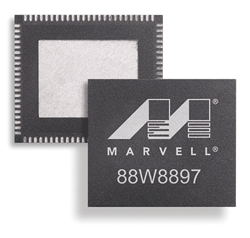802.11n and 802.11ac: A tale of two standards
Seamless wireless connectivity aided by new standard
BY BART GIORDANO
Director of Marketing
Marvell
www.marvell.com
The growing number of mobile devices used by the average consumer — paired with the popularity of new wireless applications such as HD video streaming, mobile gaming, and high-speed wireless backup — require superior Wi-Fi solutions that meet today’s bandwidth demands. To deliver seamless connectivity across various mobile platforms, nonprofit organizations such as the Wi-Fi Alliance (www.wi-fi.org) work with OEMs and chip vendors to encourage the adoption of advanced wireless standards and ensure interoperability.
Two of these standards — 802.11n and 802.11ac — were built to improve wireless connectivity for end-users for an enhanced mobile computing experience. While each has had a positive impact, the latter is expected to solidify it’s position as the No. 1 standard for today’s always-on, always-connected lifestyle.

The Marvell Avastar 88W8897 is an 802.11ac mobile MIMO dual-band wireless SoC.
A significant step forward with 802.11n
When the 802.11n standard first was published in 2009, it was regarded as a connectivity solution that would trump all others — and since that time, it has. The 802.11n standard significantly increased the network throughput of previous standards enabling a peak PHY rate of 450 Mbits/s in a three spatial stream configuration. 802.11n was the first Wi-Fi standard to support multiple-input, multiple-output (MIMO). MIMO speeds performance through the use of multiple antennae to process more data. This functionality has been integrated into nearly every cutting-edge Wi-Fi product.
The most novel capability of the 802.11n standard, however, was its ability to enhance 5-GHz operation by widening the channels for higher throughput. This flexibility allowed Wi-Fi devices to take advantage of additional bandwidth in the 5-GHz band, which is less prone to interference than the more congested 2.4-GHz band. Due to the lower costs of implementing 2.4 GHz and a broad ecosystem of existing products, however, 90% to 95% of all Wi-Fi devices still function in that band, and do not take advantage of the more efficient 5-GHz option. During the past three years, the rampant growth of Wi-Fi devices — from smartphones to baby monitors to ultrabooks — and the burgeoning ecosystem of Bluetooth-enabled devices — have overcrowded the 2.4-GHz band, and have resulted in a significant, negative impact on consumers’ mobile experience.
802.11ac for ubiquitous wireless
Today’s bandwidth-rich wireless applications require a new standard that leverages a cleaner and wider spectrum with fewer devices and less interference. The latest Wi-Fi standard, 802.11ac, operates exclusively in the 5-GHz band and enables peak PHY data rate of 1.3 Gbits/s or more. This translates to Wi-Fi connectivity that is two- to three-times faster than what is possible in the 2.4-GHz band.
This additional throughput is achieved by widening the channels within the band, and the incorporation of more complex modulation techniques. An increase in the width of the channels themselves offers additional throughput. Within the 2.4- and 5-GHz bands in 802.11n all of the channels are 20 or 40 MHz wide, while the width of the 5-GHz channels in 802.11ac are 80 MHz and can support 160-MHz-wide channels in the future.
The 802.11ac standard also encompasses a more complex channel modulation scheme than that found in 802.11n, further enhancing wireless connectivity. While 802.11n uses a 64 quadrature amplitude modulation (QAM) to encode data, 802.11ac uses a more sophisticated 256 QAM scheme. This higher throughput in a less-crowded spectrum effectively doubles the wireless performance of consumer devices, and ensures continual connectivity.
The industry continues to explore further expanding the capabilities of next-generation mobile devices, with work underway that will offer nearly instant wireless transfers and unprecedented speeds, which will be key to continued advances in the connected experience. ■
Advertisement
Learn more about Marvell Semiconductor





